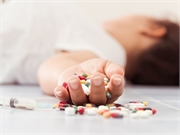Only 1.9 percent of Medicaid-enrolled youth received pharmacotherapy after nonfatal opioid overdose
TUESDAY, Jan. 7, 2020 (HealthDay News) — Less than one-third of youths surviving an opioid overdose receive timely addiction treatment, according to a study published online Jan. 6 in JAMA Pediatrics.
Rachel H. Alinsky, M.D., from the Johns Hopkins School of Medicine in Baltimore, and colleagues retrospectively analyzed data from the Truven-IBM Watson Health MarketScan Medicaid claims database (2009 to 2015) from 16 states to identify 4,039,216 Medicaid-enrolled youths (aged 13 to 22 years). Data were used to identify characteristics of those who experienced nonfatal overdose with heroin or other opioids and to assess the percentage of youths receiving timely evidence-based treatment (behavioral health services, pharmacotherapy, or both within 30 days of incident overdose).
The researchers identified 3,791 youths with nonfatal opioid overdose (58.9 percent female; 65.7 percent non-Hispanic white; median age, 18 years). Just over one-quarter (26.4 percent) experienced a heroin overdose, and 73.6 percent experienced an overdose involving other opioids. Among youths with incident heroin involvement, the risk for recurrent overdose was significantly higher than that seen among youths with other opioid overdose (adjusted hazard ratio, 2.62). Of the youths with continuous enrollment for ≥30 days after overdose, 68.9 percent received no addiction treatment within 30 days after incident opioid overdose, 29.3 percent received behavioral health services alone, and 1.9 percent received pharmacotherapy. Receipt of any treatment was significantly lower among those with heroin overdose (adjusted odds ratio, 0.64).
“Interventions are urgently needed to link youths to treatment after overdose, with priority placed on improving access to pharmacotherapy,” the authors write.
Copyright © 2020 HealthDay. All rights reserved.








